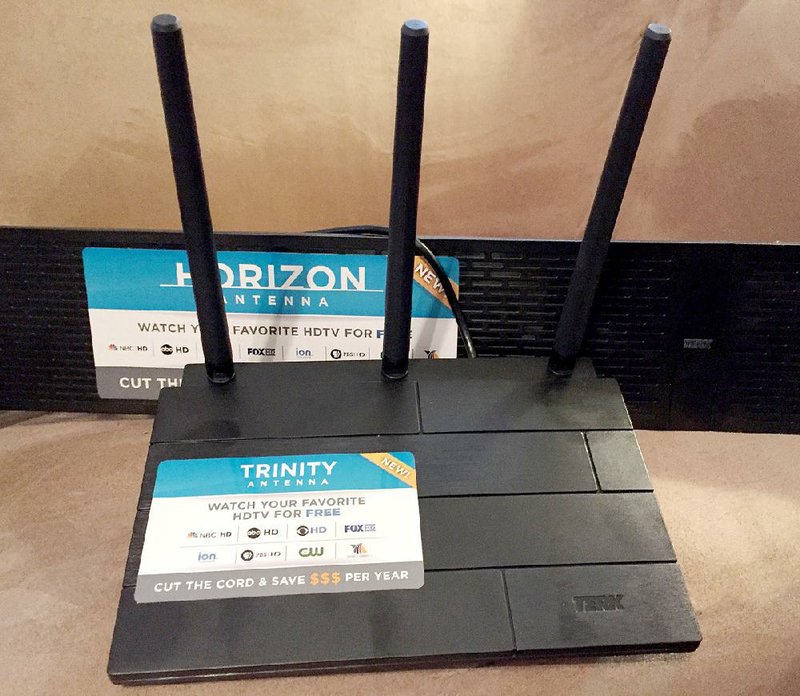It's funny how things that don't seem to be a big deal turn out to have a pretty big impact.
I've been testing a couple of products that may not seem very high tech, but that doesn't mean they won't be of interest, especially given this age of expensive cable and satellite services.
where it’s @
The Terk Trinity Amplified Indoor HDTV Antenna requires a power outlet and a television with a coaxial cable port. The Horizon Amplified Indoor HDTV Antenna requires the same, or a USB port to receive power from the television instead of an outlet. The Trinity retails for $39.99. The Horizon retails for $99. More information is available at www.terk.com.
Yes, I'm talking about television antennas.
I wasn't entirely certain that I should review television antennas. However, I reviewed one last year, the FlatWave Amplified HDTV antenna, and I've received more email and questions about that product than any other I tested in 2014. It seems many of you are cutting the cable cord or are strongly considering it.
So the question arises: Are these the products with which to do that?
Let's start with the products themselves. They're both from a company called Terk. The first is the Trinity Amplified Indoor HDTV Antenna. The second is the Horizon Amplified Indoor HDTV Antenna.
I started with the Trinity antenna. This is a compact antenna with three "ears" for added signal reception. The Trinity I tested had the ability to receive signals within 60 miles.
The Trinity easily can fit on a shelf or on top of a media player, though it will need about 8-10 inches of clearance for the upright ears. Actually, it should have a bit more than that to receive the signal properly.
The antenna connects to an amplifier that must be connected to a power outlet. The amplifier also connects to the television to bring in the antenna's signal. It's a fairly easy process to set up, and all the necessary cords are provided.
Once connected, the television should be set up for the channels with a signal scan, assuming it hasn't been set up previously. From there, it's just a question of finding the perfect spot for the signal and the perfect setup for the Trinity.
The Trinity's setup includes adjusting the three ears to accept the best signal. The adjustable ears did make a big difference with this product -- especially when compared to the other antenna.
The Horizon is the opposite of the Trinity. Rather than being compact and adjustable, the Horizon is very long, thin and rigid. It's designed to stretch across the bottom or back of a television or across a wall behind the TV.
The Horizon also contains an amplifier, but it's much smaller than the one with the Trinity. It also must be powered, but it can get its power either through a power outlet or directly from a television with a USB connection. The USB port powers the amplifier.
The Horizon comes with a mounting bracket to allow it to be mounted either to the wall or to the back of the television. It's vital to figure out exactly where the best signal is before mounting it, because the sticky pad on the mounting pad is pretty potent. Once you stick it up, it's not going anywhere easily. Terk strongly recommends cleaning the surface with an alcohol-based cleaner before attaching the mounting bracket.
To test these antennas, I employed my standard test: PBS. There are four PBS-related channels in my area, but for some reason, it's nearly impossible to get them properly on my television in the living room. (I never have trouble getting the PBS channels on my bedroom television.) The Trinity did the best, particularly after adjusting the ears. However, it wasn't perfect. If I adjusted it to receive PBS well -- which it could do -- I ended up losing the CBS channel. If I adjusted to get CBS again, some of the PBS channels would disappear. I finally was able to find a position in which I could get both, but signals were weak, so they weren't 100 percent reliable. When they did come in, however, they provided sharp, HD-quality pictures.
The Horizon didn't fare as well. Because of its size, it won't just sit on a shelf easily. Mounting it to the wall or the television is fine, so long as the best signal is in either of those areas. When it isn't, it makes it difficult to use the Horizon, because there's no great place to put it. I never could find the midpoint I found on the Trinity that allowed me to receive all my channels.
Bottom line, the Terk antennas did OK. I had much better luck with the Trinity than with the Horizon. The ability to adjust the ears on the Trinity really seemed to make a difference. Both were good, but they weren't perfect.
That said, once my tests were complete, I hooked the FlatWave antenna back to my television, and got every channel. It still gets my top vote. However, its 50-mile antenna costs a lot more than the Trinity or Horizon, and the similar 60-mile-range product costs a lot more ($99 compared with $39 for the Trinity). If you don't live very close to the free TV signals and don't want to shell out $100 for an antenna, the Trinity is a good solution. The Horizon is worth a look, but it didn't perform as well as the Trinity.
Will the Trinity have the same impact as last year's FlatWave? That depends on how many people are ready to cut the expensive cable cord this year with a less-expensive antenna.
Melissa L. Jones can be reached via email at [email protected].
SundayMonday Business on 10/12/2015

